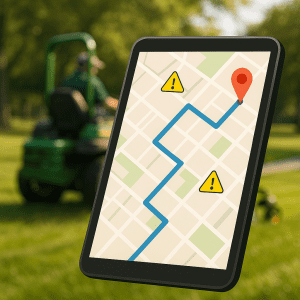In the fast-paced world of commercial landscaping, where timing and precision are crucial, smart route optimization is emerging as a major game-changer. European landscape companies are leading the way, adopting AI-powered route-planning tools that adjust crew deployment in real-time based on job progress and traffic conditions. As this innovation gains traction overseas, it presents a compelling opportunity for forward-thinking companies in North America, especially those in regions like British Columbia, to take their operational efficiency to the next level.

What’s New: Real-Time Adaptability on the Ground
Traditionally, landscape crews operate according to a set schedule and a fixed route plan developed at the beginning of the day. While this method works under ideal conditions, unexpected delays like traffic jams, weather changes, or job-site challenges often cause inefficiencies.
European companies are overcoming these hurdles by using smart route optimization systems powered by artificial intelligence. These tools don’t just map out an initial route—they monitor live job progress, traffic updates, and equipment status, continuously adjusting schedules and crew assignments in real-time.
For example, if one mowing crew finishes early while unexpected site conditions delay another, the system can instantly reassign nearby crews to balance workloads and minimize downtime.
This shift from static planning to dynamic execution enables companies to respond proactively rather than reactively, driving greater overall efficiency.

Why It Matters: Maximizing Crew Productivity
Real-time route optimization can dramatically boost productivity in a commercial landscaping operation. This is especially critical during high-pressure situations, such as snow events, where speed and coordination directly impact client satisfaction and safety.
Similarly, during peak mowing seasons when crews must service dozens of sites in a day, dynamic route adjustments help prevent bottlenecks, minimize travel time, and ensure all jobs are completed on schedule.
For companies like IslandEarth Landscape in British Columbia, where weather patterns can change rapidly and large territories need to be covered, the ability to instantly redeploy crews based on live updates can significantly increase daily output while reducing labour and fuel costs.
In a competitive market, these small operational gains translate into bigger profits and stronger client relationships.

Opportunity: Integration and Testing
One of the most exciting aspects of smart route optimization is how easily it can integrate with existing platforms already used by many landscape companies.
For example, Aspire, a popular business management system for landscapers, could further integrate real-time routing tools to enhance dispatch efficiency.
IslandEarth Landscape and other companies might also consider piloting smart routing on a smaller scale by first deploying it with their sweep or snow crews. These operations are ideal testing grounds because they involve many service locations under tight time constraints.
Success in these areas could pave the way for a full-scale rollout across all divisions, including mowing, planting, and maintenance services.

Future Vision: Predictive Maintenance and Weather Integration
The future of smart route optimization doesn’t stop with job routing. Leading-edge systems are beginning to incorporate predictive maintenance features, automatically flagging vehicles or equipment that are nearing service thresholds and adjusting routes accordingly to prevent breakdowns.
Weather integration is another exciting frontier. Imagine a platform that reroutes crews around traffic and dynamically adjusts schedules to dodge incoming storms or freezing conditions, ensuring maximum safety and uptime.
By staying ahead of these trends, companies can transform their operations from reactive to predictive — a key advantage in an increasingly competitive landscaping market.

Final Thoughts
Smart route optimization with real-time feedback isn’t just a trendy tech feature — it’s a practical and proven way to improve efficiency, boost crew productivity, and deliver better service to clients.
European landscape companies are already seeing the benefits, and there’s a strong case for commercial landscapers in British Columbia and beyond to start embracing this technology now.
For IslandEarth Landscape and similar companies, the opportunity is clear: by integrating smart routing tools into their daily operations, they can build more agile and responsive teams — and position themselves as leaders in the future of commercial landscaping.